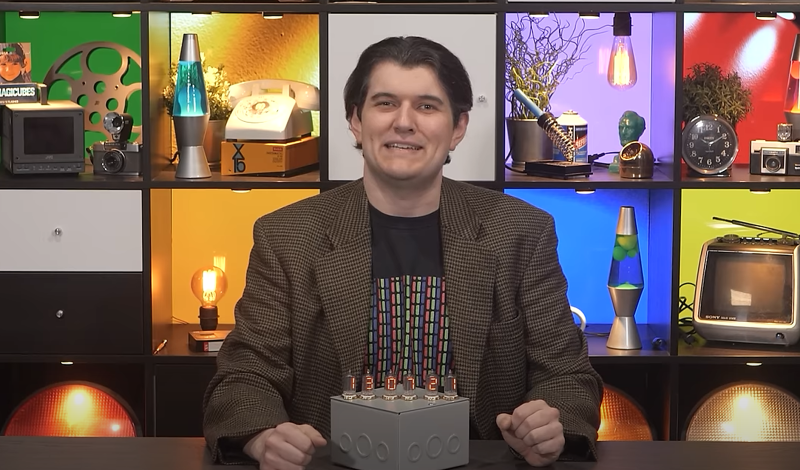In the 60’s and 70’s there were many ways to display numeric data. Nixie tubes, Vacuum Florescent Displays (VFD), micro projection systems, you name it. All of them had advantages and drawbacks. One of the simplest ways to display data was the RCA Numitron. [Alec] at Technology Connections has a bit of a love/hate relationship with these displays.
The Numitron is simply a seven-segment display built from light bulb filaments. The filaments run at 5 V, and by their nature are current limited. Seven elements versus the usual ten seen in Nixie tubes reduced the number of switching elements (transistors, relays, or tubes) needed to drive them, and the single low-voltage supply was also much simpler than Nixie or even VFD systems.
Sounds perfect, right? Well, [Alec] has a bone to pick with this technology. The displays were quite dim, poorly assembled, and not very pleasing to look at. RCA didn’t bother tilting the “8” to fit the decimal point in! Even the display background was gray, causing the numbers to wash out in ambient light. Black would have been much better. In [Alec]’s words, the best way to describe the display would be “Janky,” yet he still enjoys them. In fact, he built a fancy retro-industrial-themed clock with them.
The Numitron was not a failure, though — we know variants of this display ended up in everything from gas pumps to aircraft cockpit gauges. You can even build an LED-based replica clock — no glowing filaments necessary.

















“…didn’t bother tilting the “8” to fit the decimal point in!”
Thank you; I never twigged why 7-segment displays were so often “in italics”!
Sorry, I call BS on this. How does a tilted “8” with decimal point take up any less space than an equally-sized vertical “8” with a decimal point?
Put differently, if space constraints were reasons to omit the DP, how is tilting the number going to help?
I think the reason for no DP is simpler. A filament, by nature, is a segmented line, so it lends itself well to making a display based on line segments… but the DP…how do you make a dot from a line?
It’s easier (and cheaper) in this case to use a pea-lamp with a mask to create your decimal.
It doesn’t, but it makes it look like there’s less of a gap between the numbers when they’re leaning over the decimal point.
And the decimal point in a numitron tube is a small cross.
The left tube here has a decimal point, the right one doesn’t
http://www.tube-tester.com/sites/nixie/data/DA-DR2000/x2000-ft-tubes.jpg
Notice that the decimal point is to the left of the number, while in regular 8 segment LEDs it’s to the right of the number, and the number is leaning over the decimal point to better fill up the vertical face of the display. This is so when the numbers are put side to side, they appear to be closer together.
https://components101.com/sites/default/files/component_pin/7-segment-display-pin-diagr_0.png
tilting, however, allows you to do the colon trick. install one of the segments rotated 180 degrees and the decimal point is now top left. side by side with a normally orientated display you get a colon : that you wouldn’t be able to get if the displays weren’t in italics.
This video mostly made me realize how sad things have become for display tubes. He refers to them as incredibly rare and expensive. But there were like thousands of old Soviet IV-6 and IV-9 tubes available everywhere for like a couple bucks per unit about 5 years ago.
Guess the war took a drastic toll on their availability considering how most of them originated from the presently warring nations.
A Pity. The two numitrons were great for those wanting to try out Display tubes without any scary stuff. Unless you consider 3V and a bunch of 74HC595 shift registers scary…
They’re not exactly rare, they’re just not cheap anymore. I used to buy IV-9 Numitron tubes for ~$1.50 each by the boatload for the Numitron clock kits I used to sell on eBay. The beautiful IN-18’s could be had for $25-30 easily.
Oh well, the renewed interest in Nixie tubes is a good thing even if it means these prices are a thing of the past. There’s now 3 producers of brand new large Nixie tubes. Hope to be able to own some Dalibor tubes someday
love Technology Connections channel. This was one of the shorter videos, usually its like an hour or more.
The pinball series was fun also.
I too really enjoyed the pinball series. Amazing machines that took an absolute psychopath to design and make work so well.
Today’s numitrons are easy to replicate with led filament
Numitron tubes serve a very important modern purpose: a tube display without the strike voltage of nixies! Back in middle school, I chained a bunch of high-current shift registers, controlled them with an Arduino, and made a six-digit clock with the aid of an RTC. There’s no way I was confident enough to mess around with hundreds of volts, so Numitrons will always have a special place in my heart.
As the video points out, this advantage was only briefly unique. Once you get 7-segment LEDs, this practical advantage is no longer unique, and the only reason you’d use these is the novelty.
The reason for the dimness is simple: Life expectancy. The brighter you make them the more often they will burn out, and a burnout on a display tube can lead to quite nasty consequences. Especially if it’s the wrong segment of a 7-segment, which can change the value of a digit, unlike a Nixie which just blanks completely, or even a multiplexed LED display where you are more likely to notice that all the digits have lost the same segment.
I don’t remember planar numitrons being dim at all. They were daylight readable, when LEDs absolutely were not.
I am using a 1980 radio and the LED’s cannot be seen at all outside, unless it is after dusk.
This. The reason they were used in aircraft is that they were readable in sunlight while other readout technologies were not. Just swap them earlier to prevent burnout.
Sometimes I yearn the days when “too dim” was a problem of display/indicator lights, today they tend to be obnoxiously bright, up to the point where they can light up an entire room…
Hello, fellow fan of blue LEDs! We should form a club or something.